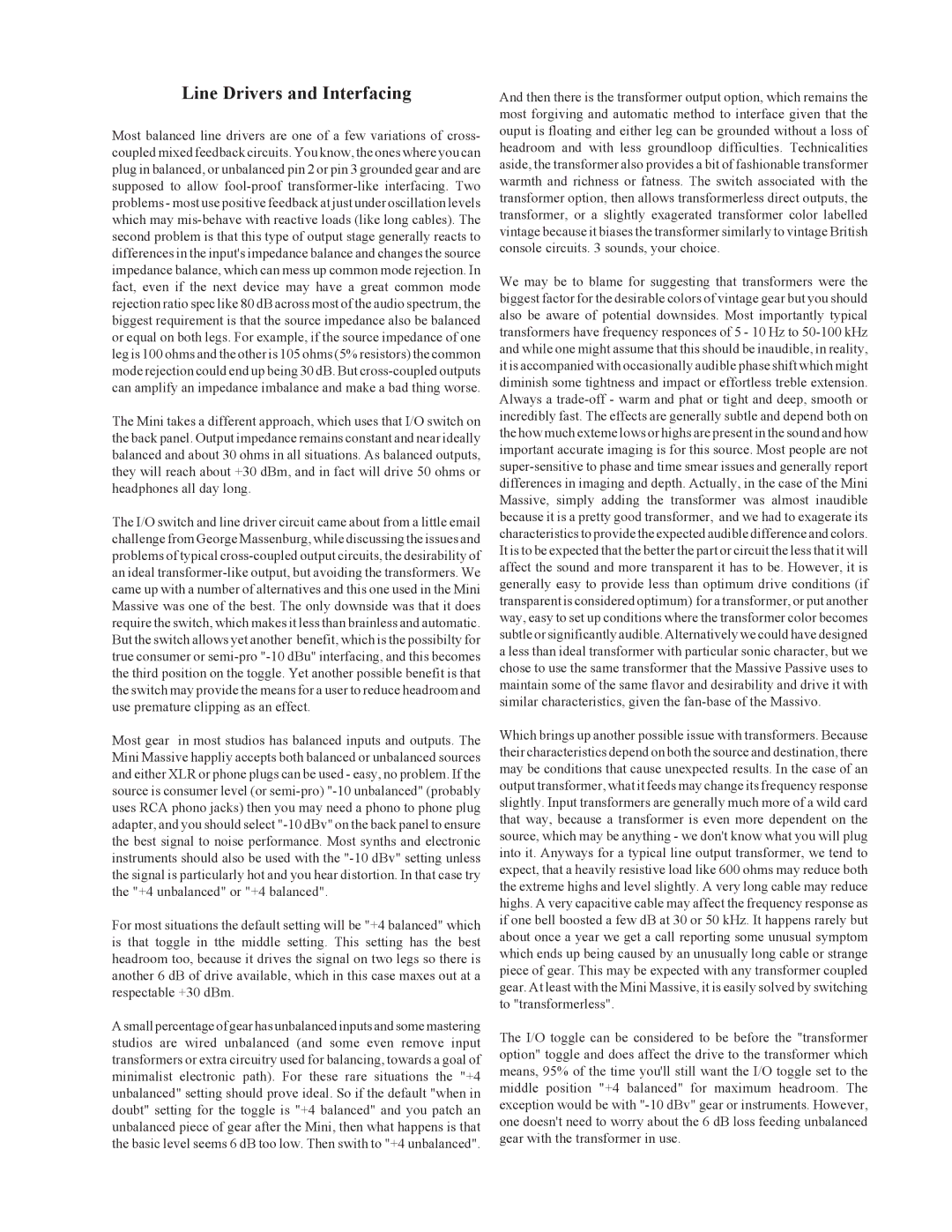Line Drivers and Interfacing
Most balanced line drivers are one of a few variations of cross- coupled mixed feedback circuits. You know, the ones where you can plug in balanced, or unbalanced pin 2 or pin 3 grounded gear and are supposed to allow
The Mini takes a different approach, which uses that I/O switch on the back panel. Output impedance remains constant and near ideally balanced and about 30 ohms in all situations. As balanced outputs, they will reach about +30 dBm, and in fact will drive 50 ohms or headphones all day long.
The I/O switch and line driver circuit came about from a little email challenge from George Massenburg, while discussing the issues and problems of typical
Most gear in most studios has balanced inputs and outputs. The Mini Massive happliy accepts both balanced or unbalanced sources and either XLR or phone plugs can be used - easy, no problem. If the source is consumer level (or
For most situations the default setting will be "+4 balanced" which is that toggle in tthe middle setting. This setting has the best headroom too, because it drives the signal on two legs so there is another 6 dB of drive available, which in this case maxes out at a respectable +30 dBm.
A small percentage of gear has unbalanced inputs and some mastering studios are wired unbalanced (and some even remove input transformers or extra circuitry used for balancing, towards a goal of minimalist electronic path). For these rare situations the "+4 unbalanced" setting should prove ideal. So if the default "when in doubt" setting for the toggle is "+4 balanced" and you patch an unbalanced piece of gear after the Mini, then what happens is that the basic level seems 6 dB too low. Then swith to "+4 unbalanced".
And then there is the transformer output option, which remains the most forgiving and automatic method to interface given that the ouput is floating and either leg can be grounded without a loss of headroom and with less groundloop difficulties. Technicalities aside, the transformer also provides a bit of fashionable transformer warmth and richness or fatness. The switch associated with the transformer option, then allows transformerless direct outputs, the transformer, or a slightly exagerated transformer color labelled vintage because it biases the transformer similarly to vintage British console circuits. 3 sounds, your choice.
We may be to blame for suggesting that transformers were the biggest factor for the desirable colors of vintage gear but you should also be aware of potential downsides. Most importantly typical transformers have frequency responces of 5 - 10 Hz to
Which brings up another possible issue with transformers. Because their characteristics depend on both the source and destination, there may be conditions that cause unexpected results. In the case of an output transformer, what it feeds may change its frequency response slightly. Input transformers are generally much more of a wild card that way, because a transformer is even more dependent on the source, which may be anything - we don't know what you will plug into it. Anyways for a typical line output transformer, we tend to expect, that a heavily resistive load like 600 ohms may reduce both the extreme highs and level slightly. A very long cable may reduce highs. A very capacitive cable may affect the frequency response as if one bell boosted a few dB at 30 or 50 kHz. It happens rarely but about once a year we get a call reporting some unusual symptom which ends up being caused by an unusually long cable or strange piece of gear. This may be expected with any transformer coupled gear. At least with the Mini Massive, it is easily solved by switching to "transformerless".
The I/O toggle can be considered to be before the "transformer option" toggle and does affect the drive to the transformer which means, 95% of the time you'll still want the I/O toggle set to the middle position "+4 balanced" for maximum headroom. The exception would be with
